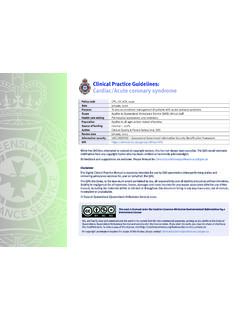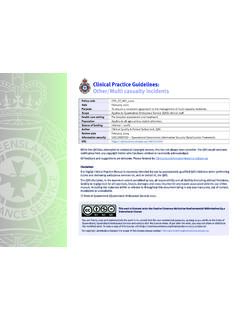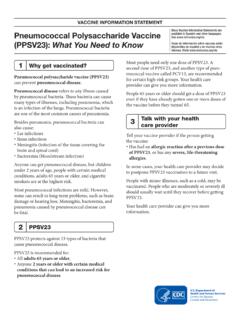Transcription of Clinical Practice Guidelines: Trauma/Spinal cord injury
1 While the QAS has attempted to contact all copyright owners, this has not always been possible. The QAS would welcome notification from any copyright holder who has been omitted or incorrectly acknowledged. All feedback and suggestions are welcome. Please forward to: The Digital Clinical Practice Manual is expressly intended for use by QAS paramedics when performing duties and delivering ambulance services for, and on behalf of, the QAS. The QAS disclaims, to the maximum extent permitted by law, all responsibility and all liability (including without limitation, liability in negligence) for all expenses, losses, damages and costs incurred for any reason associated with the use of this manual, including the materials within or referred to throughout this document being in any way inaccurate, out of context, incomplete or unavailable.
2 State of Queensland (Queensland Ambulance Service) work is licensed under the Creative Commons Attribution-NonCommercial-NoDerivatives International LicenseYou are free to copy and communicate the work in its current form for non-commercial purposes, as long as you attribute the State of Queensland, Queensland Ambulance Service and comply with the licence terms. If you alter the work, you may not share or distribute the modified work. To view a copy of this license, visit copyright permissions beyond the scope of this license please contact: codeCPG_TR_SCI_0119 DateJanuary, 2019 PurposeTo ensure a consistent appproach to the management of a patient with a spinal cord to Queensland Ambulance Service (QAS) Clinical care settingPre-hospital assessment and to all ages unless stated of fundingInternal 100%AuthorClinical Quality & Patient Safety Unit, QASR eview dateJanuary, 2022 Information securityUNCLASSIFIED Queensland Government Information Security Classification Practice Guidelines: Trauma/Spinal cord injury 309 QUEENSLAND AMBULANCE SERVICES pinal cord injury Clinical featuresImpaired motor function.
3 Diaphragmatic ventilation Paralysis Flaccidity Abnormal posturingImpaired sensory function: Local or generalised paresthesia Loss of proprioceptionImpaired autonomic function: Hypotension Bradycardia Thermoderegulation PriapismJanuary, 2019 Figure spinal cord injury (SCI) is injury of the spine or spinal cord with associated motor, sensory and/or autonomic deficit. SCI can be caused by hyperflexion, hyperextension, rotation, compression or penetrating mechanisms upon the spinal cord . The leading causes of SCI include; road traffic crash, falls, assaults, sporting injuries and recreational water activities.[1] The diagnostic pattern for SCI involves: Mechanism of injury Pain / tenderness over or adjacent to the spinal vertebra Impaired motor or sensory function Impaired autonomic functionThe principle of pre-hospital management of SCI is to limit neurological deficit and prevent secondary injury .
4 [2] This is achieved through: Appropriate spinal motion restriction Maintaining a high index of suspicion of SCI Identification and reversal of life threats in the primary survey Cardiovascular and ventilator support Ensuring appropriate thermoregulationNeurogenic shock Interruption to normal sympathetic nervous system function by high spinal cord or direct central nervous system (CNS) injury can result in loss of vasomotor tone, resultant hypotension and, in certain instances, bradycardia. Patients with neurogenic shock may present with low blood pressure, poor responses to volume replacement therapy and pronounced bradycardia. This is particularly true of spinal cord injuries involving, or above the site of the sympathetic spinal outflow (above T5).
5 spinal shockSpinal shock refers to a transient condition following acute cord injury which is characterised by flaccid paralysis below the site of the lesion, areflexia and anaesthesia. spinal shock will often resolve over the months following the initial injury and spinal reflexes will, in most instances, : Autonomic dysreflexia does not occur in the acute phase of a spinal WHEN PRINTED UNCONTROLLED WHEN PRINTED UNCONTROLLED WHEN PRINTED UNCONTROLLED WHEN PRINTED310 QUEENSLAND AMBULANCE SERVICE Risk assessment All immersion patients without a GCS of 15, should be considered to have a potential spinal cord injury until proven otherwise.[2] Paramedics can safely apply the NEXUS criteria and transport patients without spinal immobilisation, but should do so with caution when managing patients at extreme ages.
6 [3] This CPG should not replace Clinical judgement, there may be compelling reasons to immobilise the spine even if all the criteria for a low probability of injury are met.[4] Patients with SCI are at high risk of concomitant shock, haemorrhage and traumatic brain injury .[5] The CombiCarrier II and other extrication boards are not to be used as restraint devices. KED / NEIJ are inappropriate where rapid extrication is required for patients with life threatening injuries and /or vital sign alteration.[6] In such a circumstance, use MILS with all appropriate resources for extrication. Patients under the influence of drugs (including alcohol) require additional assessment and questioning before ruling out a c-spine injury , caution must be used in this National Emergency X-Radiography Utilization Study (NEXUS)The NEXUS was a large, multicentre study involving 21 emergency departments in the United States of America which looked at the practical application of patient Clinical assessments as indicators for c-spine radiography.
7 [5] The study indicated that radiography is required for patients unless they meet ALL of the following criteria: [7] No posterior midline cervical-spine tenderness- Midline posterior bony cervical-spine tenderness is present if the patient complains of pain on palpation of the posterior midline neck from the nuchal ridge to the prominence of the first thoracic vertebra, or if the patient evidences pain with direct palpation of any cervical spinous process. No evidence of intoxication- Patients should be considered intoxicated if they have either of the following: a recent history provided by the patient or an observer of intoxication or intoxicating ingestion, or evidence of intoxication on physical exam such as an odour of alcohol, slurred speech, ataxia, dysmetria, or other cerebellar findings, or any behaviour consistent with intoxication.
8 Patients may also be considered intoxicated if tests of body secretions are positive for alcohol or other drugs which affect the level of alertness. A normal level of alertness- An altered level of alertness can include any of the following: a Glasgow Coma Scale score of 14 or less; disorientation to person, date, time or events; an inability to remember three (3) objects at five (5) minutes; a delayed or inappropriate response to external stimuli; or other WHEN PRINTED UNCONTROLLED WHEN PRINTED UNCONTROLLED WHEN PRINTED UNCONTROLLED WHEN PRINTED311 QUEENSLAND AMBULANCE SERVICE Additional information NEXUS has been validated in both adult and paediatric populations. In the pre-hospital setting the NEXUS criteria is a highly sensitive and selective decision-making protocol aimed to identify trauma patients who are at very low risk of sustaining a SCI, and therefore could be transported without spinal motion restriction.
9 [7] C-spine clearance often requires imaging, however children may still present with spinal cord injury without radiological abnormality (SCIWORA). No focal neurological deficit- A focal neurologic deficit is determined as any abnormality, be it sensory or motor, found on examination. No painful distracting injuries- No precise definition of painful distracting injury is possible. This category includes any condition thought by the clinician to be producing pain sufficient to distract the patient from a second (neck) injury . Such injuries may include, but are not limited to, any long-bone fracture; a visceral injury requiring surgical consultation; a large laceration, degloving injury , or crush injury ; large burns; or any other injury causing acute functional impairment.
10 CPG: Clinician safetyCPG: Standard caresTransport to an appropriate destination ( spinal centre)Consider appropriate transport modalities (air transport)NEXUS (are any of the following present): midline tenderness evidence of intoxication ALOC focal neurological deficit any distracting injuryApply mandatory spinal motion restrictionConsider neurogenic shock: FAST IV fluids Inotropic support Analgesia AntiemeticConsider: Analgesia AntiemeticYConsider other injuries: FAST IV fluids Analgesia AntiemeticHypotensive & bradycardic?Spiral motion restriction not mandatory?Hypotensive & trachycardic?Note: Clinicians are only to perform procedures for which they have received specific training and authorisation by the WHEN PRINTED UNCONTROLLED WHEN PRINTED UNCONTROLLED WHEN PRINTED UNCONTROLLED WHEN PRINTED













